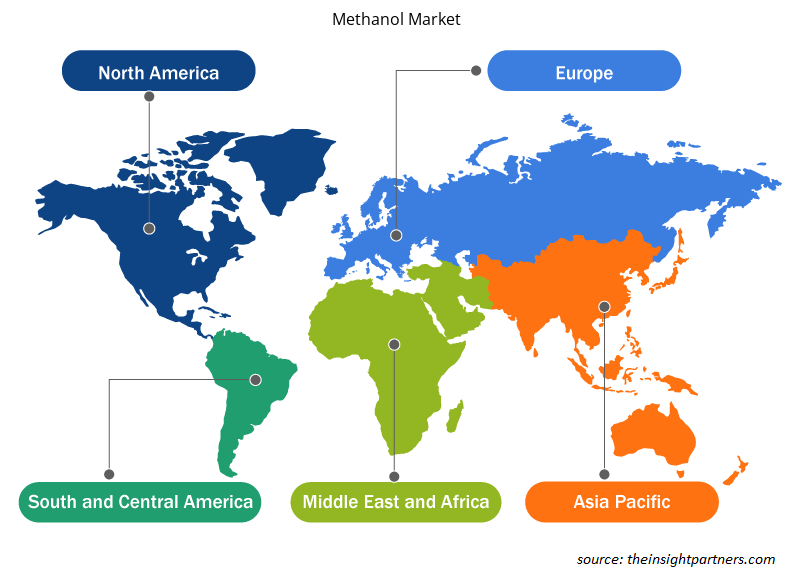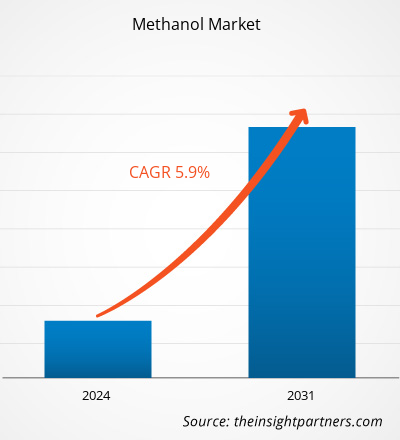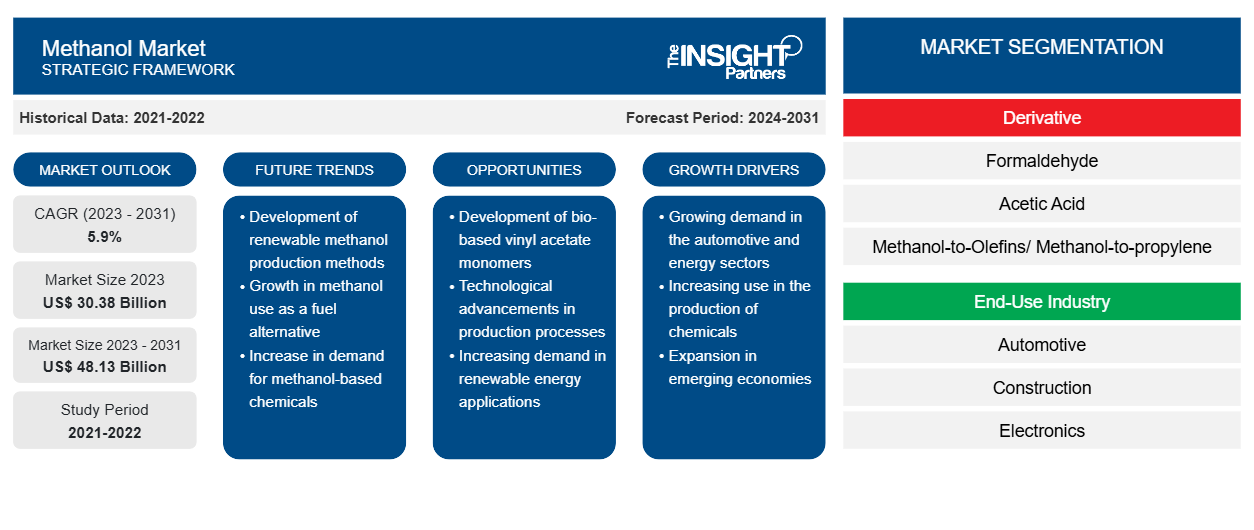预计到 2031 年,甲醇市场规模将从 2023 年的 303.8 亿美元增至 481.3 亿美元。预计 2023-2031 年市场复合年增长率为 5.9%。运输行业越来越多地采用甲醇作为混合燃料,这可能仍是甲醇市场的一个关键趋势。
甲醇市场分析
全球各国建筑活动的快速增长推动了甲醇市场的增长。建筑业是墨西哥最具前景的行业。由于经济增长和对基础设施项目的公共投资,墨西哥建筑业正在增长。墨西哥也在迅速转向绿色环保的建筑活动。在过去几年中,印度尼西亚的建筑业一直是增长动力。快速的城市化人口推动了该国建筑业的需求。此外,人口增长和政府对基础设施支出的增加是印度尼西亚建筑市场的主要驱动力。
甲醇市场概况
甲醇是最简单的醇化合物,在工业应用中用作添加剂;它是一种易燃、无色、有毒的液体化学品,气味微弱。它用于汽车、建筑、电子、包装、制药、油漆和涂料等各种行业。甲醇用于生产甲醛、乙酸和甲基丙烯酸甲酯 (MMA),也用作多种应用中的溶剂。甲醇及其通过化学反应生成的衍生产品(如乙酸和甲醛)用作丙烯酸塑料的基础材料;用于制造服装的合成织物和纤维;建筑中使用的粘合剂、油漆和胶合板;以及作为药物和农用化学品中的化学剂。
定制此报告以满足您的需求
您可以免费定制任何报告,包括本报告的部分内容、国家级分析、Excel 数据包,以及为初创企业和大学提供优惠和折扣
-
获取此报告的关键市场趋势。这个免费样品将包括数据分析,从市场趋势到估计和预测。
甲醇市场驱动因素和机遇
甲醇作为原料在各种应用中的使用日益增多
甲醇是一种重要的化学构件或燃料,当由可再生资源制成时,它可以帮助实现脱碳目标。甲醇广泛用于生产塑料、粘合剂、绝缘材料、纺织品和食品化学品以及其他化学品和化合物。由于全球汽车行业的增长,对塑料的需求正在增加。此外,各种甲醇衍生物广泛用于制药和医疗保健行业。因此,增加甲醇在各种应用中的使用可以促进全球甲醇市场的增长。
使用绿色甲醇日益受到关注
绿色甲醇是可再生且无污染排放的甲醇。这种化合物用作低碳液体燃料,在脱碳是一项重大挑战的地区是一种有前途的化石燃料替代品。近年来,传统化石燃料的可持续低碳替代品已成为当务之急。因此,对使用绿色甲醇的日益关注预计将为市场增长提供更多有利可图的机会。
甲醇市场报告细分分析
有助于得出甲醇市场分析的关键部分是衍生品和最终用途行业。
- 根据衍生物,甲醇市场细分为甲醛、乙酸、甲醇制烯烃 (MTO)/甲醇制丙烯 (MTP)、甲基叔丁基醚 (MTBE)、甲基丙烯酸甲酯 (MMA)、生物柴油、二甲醚 (DME) 等。甲醛部分在 2023 年占有相当大的市场份额。
- 根据最终用途行业,市场细分为汽车、建筑、电子、包装、制药、油漆和涂料等。2023 年,汽车行业占据了相当大的市场份额。
甲醇市场份额按地区分析
甲醇市场报告的地理范围主要分为五个区域:北美、亚太、欧洲、中东和非洲、南美和中美。
亚太地区在全球市场占有较大份额。预计北美在预测期内将实现可观的增长率。甲醇广泛用于生产各种化学品和化合物,如塑料、粘合剂、绝缘材料、纺织品和食品化学品。由于该地区汽车工业的不断发展,对塑料的需求不断增加,这对甲醇市场有利。汽车行业大量使用塑料聚合物来制造车辆的内部结构和其他部件,如保险杠、燃油系统、驾驶室、门把手、刹车片和引擎盖下的部件。塑料部件的应用显著减轻了车辆的重量,提高了燃油效率,并符合有关化石燃料碳排放的环境法规。
甲醇市场区域洞察
Insight Partners 的分析师已详细解释了预测期内影响甲醇市场的区域趋势和因素。本节还讨论了北美、欧洲、亚太地区、中东和非洲以及南美和中美洲的甲醇市场细分和地理位置。

- 获取甲醇市场的区域具体数据
甲醇市场报告范围
| 报告属性 | 细节 |
|---|---|
| 2023 年的市场规模 | 303.8亿美元 |
| 2031 年市场规模 | 481.3亿美元 |
| 全球复合年增长率(2023 - 2031) | 5.9% |
| 史料 | 2021-2022 |
| 预测期 | 2024-2031 |
| 涵盖的领域 |
按衍生品
|
| 覆盖地区和国家 |
北美
|
| 市场领导者和主要公司简介 |
|
甲醇市场参与者密度:了解其对业务动态的影响
甲醇市场正在快速增长,这得益于终端用户需求的不断增长,而这些需求又源于消费者偏好的不断变化、技术进步以及对产品优势的认识不断提高等因素。随着需求的增加,企业正在扩大其产品范围,进行创新以满足消费者的需求,并利用新兴趋势,从而进一步推动市场增长。
市场参与者密度是指在特定市场或行业内运营的企业或公司的分布情况。它表明在给定市场空间中,相对于其规模或总市场价值,有多少竞争对手(市场参与者)存在。
在甲醇市场运营的主要公司有:
- 梅赛尼克斯公司
- 奥西尼公司
- 巴斯夫
- 沙特基础工业公司
- 三菱瓦斯化学株式会社
- 赫尔姆公司
免责声明:上面列出的公司没有按照任何特定顺序排列。

- 了解甲醇市场主要参与者概况
甲醇市场新闻及最新动态
甲醇市场的评估是通过收集一手和二手研究后的定性和定量数据进行的,其中包括重要的公司出版物、协会数据和数据库。以下是甲醇市场的发展和战略列表:
- 三井物产株式会社已同意收购欧洲能源公司(EE,一家总部位于丹麦索博格的可再生能源公司)的子公司 Kasso MidCo ApS(“MidCo”)49% 的股权。MidCo 通过其全资子公司 Solar Park Kasso ApS(“Kasso”)拥有太阳能发电和电子甲醇业务。(来源:三井物产株式会社,公司网站/新闻稿/2023 年)
- 印度可再生和新能源公司 Jakson Green 今天宣布,该公司已赢得国家火电公司 (NTPC) 的一个项目,将在印度中央邦 NTPC 的 Vindhyachal 火电厂建立一个二氧化碳转化为甲醇的生产设施。(来源:PV MAGAZINE、公司网站/2023)
甲醇市场报告覆盖范围和交付成果
“甲醇市场规模和预测(2021-2031 年)”报告对市场进行了详细的分析,涵盖以下领域:
- 范围内所有主要细分市场的全球、区域和国家层面的市场规模和预测
- 市场动态,如驱动因素、限制因素和关键机遇
- 未来的主要趋势
- 详细的波特五力分析和 SWOT 分析
- 全球和区域市场分析涵盖关键市场趋势、主要参与者、法规和最新市场发展
- 行业格局和竞争分析,涵盖市场集中度、热点图分析、知名参与者和最新发展
- 详细的公司简介
- 历史分析(2 年)、基准年、预测(7 年)及复合年增长率
- PEST和SWOT分析
- 市场规模、价值/数量 - 全球、区域、国家
- 行业和竞争格局
- Excel 数据集
近期报告
客户评价
购买理由
- 明智的决策
- 了解市场动态
- 竞争分析
- 客户洞察
- 市场预测
- 风险规避
- 战略规划
- 投资论证
- 识别新兴市场
- 优化营销策略
- 提升运营效率
- 顺应监管趋势























 获取免费样品 - 甲醇市场
获取免费样品 - 甲醇市场